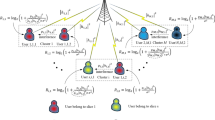Abstract
Virtualized Wireless Networks (VWN) strive to offer efficient power allocation and spectral efficiency to each user assigned to a given slice at any time. We propose a user-slice association based on the softmax of the probability of successful transmission using space- time block code (STBC) to encode the data transmission in a wireless channel. Each slice is defined by a set of Base stations (BS) or relays or Access Points (APs) or Small cell Base Stations and their related physical resources or a combination of such stations. The slices constitute a distributed-space-time block code which provides the data traffic for the mobile terminals. A maximisation of the ergodic capacity is used to find the optimal transmit power at each slice. The optimisation is constrained by the outage at the small cell located near the cooperating transmit slices. Such constraint improves the initialisation of the iterative algorithm compared to randomly choosing initial points. The proposed optimisation yields a dynamic selection of the slices with power control pertaining to the outdoor mobile terminal performance and the outage. The simulations show that the selection of a slice based on the softmax of the probability of successful transmissions ensures a better probability of successful transmissions compared to a permutation based selection.
Access this chapter
Tax calculation will be finalised at checkout
Purchases are for personal use only
Similar content being viewed by others
References
Hossain, E., Hasan, M.: 5G cellular: key enabling technologies and research challenges. IEEE Instrum. Meas. Mag. 18, 11–21 (2015)
Liang, C., Yu, F.R.: Wireless network virtualization: a survey, some research issues and challenges. IEEE Commun. Surv. Tutor. 17, 358–380 (2014)
Costa-Perez, X., Guo, T., Mahindra, R., Rangarajan, S.: Radio access network virtualization for future mobile carrier networks. IEEE Wirel. Commun. Mag. 517, 27–35 (2013)
Zhu, K., Hossain, E.: Virtualization of 5G cellular networks as a hierarchical combinatorial auction. IEEE Trans. Mob. Comput. 15(10), 2640–2654 (2016)
http://www.artizanetworks.com/resources/tutorials/cran.html. Accessed 1 Nov 2018
Ndong, M., Fujii, T. : Joint antenna selection and power allocation for distributed-stbc cognitive small cell networks. In: International Symposium on Wireless Personal Multimedia Communications (WPMC), pp. 439–444 (2014)
Alamouti, S.: A simple transmit diversity technique for wireless communications. IEEE J. Select. Areas Commun 16(8), 1451–1458 (1998)
Tarokh, V., Jafarkhani, H., Calderbank, A.R.: Space-time block coding for wireless communications: performance results. IEEE J. Select. Areas Commun. 17(3), 451–460 (1999)
Lu, Z., Cimini, L.J.: Efficient power allocation for decentralized distributed space-time block coding. IEEE Trans. Wireless Commun. 8(3), 1102–1106 (2009)
Dohler, M., Aghvami, A.H., Zhou, Z., Li, Y., Vucetic, B.: Near-optimum transmit power allocation for space-time block encoded wireless communication systems. IEE Proc.-Commun. 153(3), 459–463 (2006)
Win, M.Z., Winters, J.H.: Analysis of hybrid selection/maximal-ratio combining of diversity branches with unequal SNR in Rayleigh fading. In: Vehicular Technical Conference (VTC), pp. 215–220 (1999)
Proakis, J.G., Salehi, M.: Digital Communication, 5th edn. McGraw Hill, USA (2008)
Jian, C., Haifeng, W., Lilleberg, J., Shixin, C.: Unequally powered STBC for slow flat Rayleigh fading channel. In: Wireless Communication and Network Conference (WCNC), pp. 291–295 (2002)
Prayongpun, N.: Modélisation et étude de la capacité du canal pour un système multi-antennes avancé exploitant la diversité de polarisation. Traitement du signal et de l’image [eess.SP]. Université Joseph-Fourier - Grenoble I (2009)
Gao, B., Pavel, L.: On the properties of the softmax function with application in game theory and reinforcement learning. arXiv:1704.00805 (2018)
Wang, J.C., Jiang, H., Zhang, X., Leung, V.C.M., Hanzo, L.: Learning-aided network association for hybrid indoor LiFi-WiFi systems. IEEE Trans. Vehicular Technol. 67, 3561–3574 (2018)
Wildemeersch, M., Quek, T.S., Slump, C.H., Rabbachin, A.: Cognitive small cell networks: energy efficiency and trade-Offs. IEEE Trans. Wireless Commun. 61(9), 4016–4029 (2013)
Khan, F.A., Yunfei, C., Alouini, M.-S.: Novel receivers for AF re-laying with distributed STBC using cascaded and disintegrated channel estimation. IEEE Trans. Wireless Commun. 11(4), 1370–1379 (2012)
Razi, A., Afghah, F., Abedi, A.: Power optimized DSTBC assisted DMF relaying in wireless sensor networks with redundant super nodes. IEEE Trans. Wirel. Commun. 12(2), 636–645 (2013)
http://citeseerx.ist.psu.edu/viewdoc/download?doi=10.1.1.139.1720&rep=rep1&type=pdf. Accessed 02 Jan 2020
Author information
Authors and Affiliations
Corresponding author
Editor information
Editors and Affiliations
Rights and permissions
Copyright information
© 2023 The Author(s), under exclusive license to Springer Nature Switzerland AG
About this paper
Cite this paper
Diouf, M.D., Ndong, M. (2023). Network Slicing User Association Under Optimal Input Covariance Matrix in Virtual Network MVNO. In: Ben Ahmed, M., Abdelhakim, B.A., Ane, B.K., Rosiyadi, D. (eds) Emerging Trends in Intelligent Systems & Network Security. NISS 2022. Lecture Notes on Data Engineering and Communications Technologies, vol 147. Springer, Cham. https://doi.org/10.1007/978-3-031-15191-0_34
Download citation
DOI: https://doi.org/10.1007/978-3-031-15191-0_34
Published:
Publisher Name: Springer, Cham
Print ISBN: 978-3-031-15190-3
Online ISBN: 978-3-031-15191-0
eBook Packages: Intelligent Technologies and RoboticsIntelligent Technologies and Robotics (R0)




